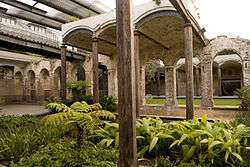Paddington Reservoir
| Paddington Reservoir | |
|---|---|
|
Western Chamber, Paddington Reservoir Gardens | |
| Location | Paddington, New South Wales |
| Coordinates | 33°53′07″S 151°13′37″E / 33.8853°S 151.22697°ECoordinates: 33°53′07″S 151°13′37″E / 33.8853°S 151.22697°E |
| Elevation | 64 |
| Built | 1866 |
| Built for | Metropolitan Board of Water and Sewerage, Sydney |
| Restored | 2008 |
| Restored by | Tonkin Zulaikha Greer |
| Architect | Edward Bell |
The Paddington Reservoir was a water reservoir which accepted water from the Botany Swamps pumping station for supply to parts of Sydney between 1866 and 1899. In 2006 it was converted into a sunken garden and park known as the Paddington Reservoir Gardens or Walter Read Reserve.
History
Construction and operation
The plan for Paddington Reservoir began with the creation of the Botany Swamps water scheme in 1859. This water scheme, developed by Edward Bell and Will Wadsworth proposed a number of reservoirs at critical points around the city. Construction of the Paddington Reservoir was completed by 1866[1] and connected to the Botany Swamps pumping station. This offered a new source of water to elevated suburbs of Sydney which had up until then had only been serviced by wells and a water-cart service.
The reservoir was constructed of brick with ironbark columns which were erected in mortises in stone foundations at the base of the reservoir. These columns supported cast iron beams which in-turn supported segmental arches which formed the roof of the structure.
However, due to its limited elevation, only the top five feet of water from the reservoir could be provided to buildings in excess of one storey. In order to reduce the load on the Botany Swamps pumping station, a further pumping station at the Crown Street Reservoir was commenced in 1875 which also assisted in the delivery of water to the Paddington Reservoir.[2]
In 1877 a second chamber was added to the Paddington Reservoir, dubbed the eastern chamber (with the original chamber being the western chamber) this increased the storage of the facility to meet the demands of the rapidly expanding city. In 1899 the facility was decommissioned following the completion of the larger and further elevated Centennial Park Reservoir.[3][4]
Post-reservoir
The facility was used by the Sydney Metropolitan Board of Water Supply and Sewerage (Water Board) as a storage facility, following its decommissioning, primarily storing pipes at the location.[1] In 1910, the facility was used by the Water Board's Motor Branch for the storage of motor vehicles. In 1926 the facility was converted to provide additional storage for motor vehicles at which time several timber columns were removed and replaced with steel beams to allow for vehicle maneuvering. Water penetrated the roof at a later time, and a secondary roof was constructed below the existing roof to protect the vehicles housed at the facility.
The ex-reservoir was sold to Paddington Municipal Council in 1934 for £3750.[5] The Water Board leased the eastern chamber of the facility and continued to use it for motor vehicle and general storage until the late 1950s. The western chamber was leased to a commercial motor garage operator in 1934 which led to the construction of a ramped entry from Oxford Street into the western chamber. During this period the roof of the facility was converted for use as a public reserve, allowing access to the roof for recreational purposes. This roof-top reserve was later named the Walter Read reserve.
In July 1990 part of the roof of the western chamber of the former-reservoir, still used as a motor vehicle service station, collapsed. This collapse in 1990 and a further collapse occurred as a result of corrosion of steel structure placed in 1926 to allow vehicle movement in the underground reservoir chambers. This caused the closure of the reserve atop the roof, and the service station below.
Paddington Reservoir Gardens
In 2006 architects Tonkin Zulaikha Greer and landscape architects JMD Design began work to conserve, restore and reuse the space of the then derelict Paddington Reservoir. The facility reopened in 2008 as a sunken garden with rooftop reserve above the preserved eastern chamber. The facility integrates the remains of the original brick, timber and iron structure with modern elements of sculptural, structural and functional significance which provide access to the sunken garden via stairs and an elevator as well as ramped access to the rooftop reserve.
References
| Wikimedia Commons has media related to Oxford Street, Sydney. |
- 1 2 "Paddington Reservoir Gardens". City of Sydney Council. Retrieved 4 July 2010.
- ↑ "SYDNEY WATER SUPPLY.". The Sydney Morning Herald (12,729). New South Wales, Australia. 18 January 1879. p. 6. Retrieved 9 July 2016 – via National Library of Australia.
- ↑ "Paddington Reservoir Review for Monument Magazine". Super Colossal. 11 August 2009. Retrieved 4 July 2010.
- ↑ "CENTENNIAL PARK RESERVOIR.". The Sydney Morning Herald (18,535). New South Wales, Australia. 11 August 1897. p. 3. Retrieved 9 July 2016 – via National Library of Australia.
- ↑ "RESERVOIR SITE.". The Sydney Morning Herald (29,810). New South Wales, Australia. 19 July 1933. p. 12. Retrieved 9 July 2016 – via National Library of Australia.
